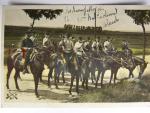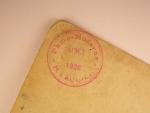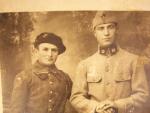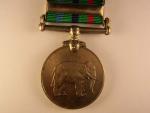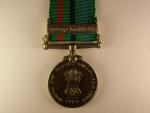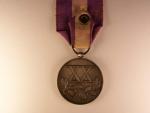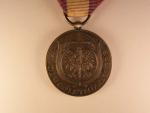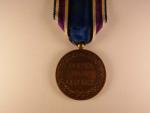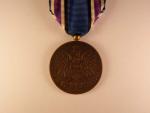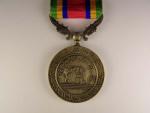-
Posts
6,486 -
Joined
-
Last visited
-
Days Won
10
Content Type
Profiles
Forums
Blogs
Gallery
Events
Store
Everything posted by Brian Wolfe
-
Hello everyone, This is another post card I purchased lately. I believe it is of a group of mounted French buglars. It looks to have been in colour at one time but only traces of blue and green are left along with a few red stripes. In the lower left corner is an insignia with E and P on either side of a pair of crossed swords with 217 below. The soldiers have cap badges but even under high magnification I can not make out any design. The insignia seems to be stitched rather than being hat badges. The uniform pants and hats are blue as is the tunic on the officer and NCO at either end of the group. I think there is mention of the 72nd Btn. in the written caption on the front and I see Verdun mentioned on the back of the postcard. There is a farmer in the background looking on so I am thinking this is a photo of soldiers in training somewhere in the French countryside. Could someone please help with the identification as well as the translations? Many thanks for any help you can give me. Cheers Brian
-
-
-
Here is a closer view of the insignia. The soldier on the left has the number 22 above what looks like a bugle. I've seen this "bugle" insignia somewhere else but I can't locate those notes at the moment. The beret badge does not show up even under high magnicication but it is a tear-drop shape, he is wearing cords on the left shoulder. The soldier on the left has clearly marked collars, numbered 19 and the wedge shaped hat has a single cheveron. The boots look like calvary but that may just be me wanting it to be calvary. What are your thoughts? Cheers Brian
-
Hello Everyone, I recently purchased a couple of photo post cards and this one was tagged as being two soldiers of the Austro-Hungarian Army. I though they looked like French uniforms and there was a photographers stamp on the back that dated the photo as being from 1926, which would make if pretty well impossible to be from the Austro-Hungarian Empire. Also the location of the photograhper's studio is given as Nimes, which I believe is in France. I will post a closeup of the two showing the collar markings next. I liked the sword held by the fellow on the right and I am wondering if this indicates he was in the post 1918 French Calvary? I realize that photo props do not always indicate rank or affiliation. Any help with nationality, rank or any other information would be greatly appreciated. Cheers Brian
-

Which model bayonet?
Brian Wolfe replied to Chris Boonzaier's topic in Great Britain: Militaria: Badges, Uniforms & Equipment
Hi Peter, I've heard this since I was a kid and I'm not sure I totally agree with you on this point. I've never been in the military so I admit to not having real-life experience, however, I would think that in cases of prisoner escort or crowd control a bayonet on the end of a rifle makes a pretty good point (no pun intended). I guess it's a matter as to whether these duties are worth issuing bayonets in this day and age of full autos, then again opening up on an out of control crowd of protestors would look bad in the morning paper and up set the public during their breakfast. Back to the No. 4. I don't have the references in front of me at the momnent but I recall that when the British government was looking for a new design of bayonet it was decided that they needed one that would be able to go through the thickest battle dress of any potential enemy of the time (post WWI). That potential enemy was considered to be the Russians and in full winter gear the thickness that needed to be penetrated was 4 inches. Therefore the no. 4, it was decided, needed to be 200 mm (around 7 3/4 inches). Cheers Brian -

Which model bayonet?
Brian Wolfe replied to Chris Boonzaier's topic in Great Britain: Militaria: Badges, Uniforms & Equipment
It won't stay that way if you poke it in the ground. Cheeers Brian -
Hi Ed, Thanks for the additional research information and thanks to Jagan for all of his work as well. I never think to check our SAGongs on Yahoo. Cheers Brian
-
Hi Ed, There was no unit listed on the medal. I hope your check of the service number ranges will answer that mystery. Many thanks Brian
-
Hi Laurence, Yes it is just the camera. I must spend more time on honing my photographic skills. I also noticed that this was not listed on Ed's web pages. It would not suprise me to find it in his upcoming book. When your new singles arrive please make sure you post them, India and Pakistan are not too well represented on the forum. Cheers Brian
-
-
-
Hello Everyone, I've just received a medal from a dealer in India for my collection and I wanted to show it off. This is the Samanya Seva Medal (1965) with the Manipur clasp. The Samanya Seva Medal (1965) is the successor to the GSM 1947. The Manipur clasp was awarded for service in Manipur State which in in North East India. During the British rule Manipur was a Princely State and was the last state to join independent India. This is classed as a sensitive area and tourist travel is very restricted. For more on Manipur and to save me a lot of typing check out Google or Wikipedia. This medal was awarded to, 14262115 NK. OMVIR SINGH I hope you like this new addition, it is the first time I've seen the Manipur clasp. Cheers Brian
-
Hello Everyone, Here is the second medal I purchased on the weekend to add to my Polish collection. It is a 20 year service medal that was awarded to both Civil and Military personnel. The medal is hallmarked with an inverted sheild-shaped mark with what is best described as looking like the Japanese Kanji symbol for the number 6, it is also marked "Ag. 0.095". The medal was instituted in 1938 and this particular medal looks to have a good deal of wear and age, so it may be an earlier one. The ribbon is faded but correct. The ribbon looks like it may have been meant to be in the triangular shape similar to the Austrian Medals of WW I. I say this because of the eyelet that can be seen in the obverse view. Once again any comments are welcomed. I hope you like my finds, they're not spectacular but I like them. Cheers Brian
-

Polish Medal for the 1918 - 1921 War
Brian Wolfe replied to Brian Wolfe's topic in Central & Eastern European States
-

Polish Medal for the 1918 - 1921 War
Brian Wolfe posted a topic in Central & Eastern European States
Hello Everyone, My weekend hunting trip landed me a couple of new Polish medals for my collection as well as a British 2 pound shell (but that's for another area of the forum). The first medal is the 1918 - 1921 War Medal awarded to Veterans of the Polish Soviet War also known as the Russo-Polish War of 1920. The following information comes from a site on Google titled "The Polish Russian War and the fight for Independence 1918 - 1921", check it out it is very interesting. "Between 1918 & 1921 Poland had to fight to re-establish itself as a nation. The most dangerous enemy that Poland faced at the time was Bolshevik Russia, under Lenin. This War and the important events surrounding it are vertually absent from most history books. This is surprising given the huge impact on Europe that would have occured had Poland lost this War". The medal looks it be in such good condition to lead me to think it may be a resent striking, however, it is of quite good quality. Any comments regarding this would be welcomed. The ribbon is correct and in like-new condition and is of the "watered" type so the quality is once again excellent. It is unnamed as issued. Cheers Brian -

Which model bayonet?
Brian Wolfe replied to Chris Boonzaier's topic in Great Britain: Militaria: Badges, Uniforms & Equipment
Nope, not rare but you didn't pay too much. I've seen them from $15.00 to $25.00 Canadian at shows. I used to have the whole set but lost them during the Dark Ages (divorce). Cheers Brian -

Which model bayonet?
Brian Wolfe replied to Chris Boonzaier's topic in Great Britain: Militaria: Badges, Uniforms & Equipment
Hi Chris, You have a British No. 4 Mk III. What you are used to seeing are the earlier models which are of much better quality. The first Bayonet in this series was the Mk I (I guess that goes without saying) and had a blade that was cruciform in cross section. I've included a photo of an entry from Paul Kiesling's book "Bayonets of the world" Volume One as a reference for you. Cheers Brian -
Hi Eric, The more I see this sword the more I like it. I agree with the other members that the tip has been reworked. I've seen this on other swords, some I've owned. I had a British bandsmans sword once with the tip reworked. Mine like yours, was expertly done and not a backyard mechanic grinder job. Thanks for the close up of the blade. Very nice indeed. Cheers Brian
-

My new Thailand Medal has arrived
Brian Wolfe replied to Brian Wolfe's topic in South East & East Asia
Here is the Obverse according to the source I am going by. For some reason I really liked this medal from the first time I saw it offered for sale. I hope you like it as well. Cheers Brian -
Hello Everyone, This medal is the Chakra Mala Medal established in the reign of King Chulalongkorn Rama V the Great, around 2415BE (1872AD) to give to soldiers or police officers who served the country for more than 15 years. Obverse: The Royal Chula Mongkut (Minor Crown) with regalia (emblem of H.M. King Chulalongkorn Rama V) Reverse: The decorated White Elephant (symbol of Siam) facing left with the Thai alphabet, "S.P.P.M.C.5" abbreviation of "Somdej Pra Poramindra Maha Chulalongkorn the V". Ribbon: Red with blue, yellow, greenstripes 30mm. width. The decree requires that this medal can be recalled, and in case of return, a fine of 932 Baht must be submitted. Size: dia. 38 mm. Weight: 25 grams Reference: Royal Thai Order and Decoration, The Secretariat Office of the Office of the Prime Minister, Thailand. I have found other references that state the Obverse is the elehpant and the reverse is the Royal Regalia. While I like the look of the elephant the Royal regalia is most likely the logical obverse. Another source states this was awarded for 25 years devotional service in the civil service. Perhaps the criteria has changed somewhat over the years but the Office of the Prime Minister's criteria holds a lot of weight in my mind. Also this particular medal is said to have probably been awared in the 1970s which I tend to think is accurate. Any thoughts or comments are, as always, welcomed. I accidently posted the reverse of the medal first, sorry, I hope it does not confuse the issue. Cheers Brian



